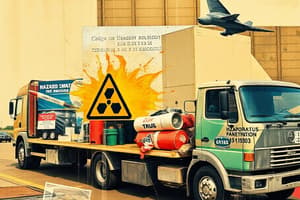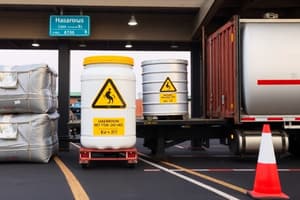Podcast
Questions and Answers
"_________" A substance or material capable of posing an unreasonable risk to health, safety, or property when transported in commerce.
"_________" A substance or material capable of posing an unreasonable risk to health, safety, or property when transported in commerce.
- Chemical
- Hazardous material (correct)
- Flammable substances
- Agriculture material
A "_________" is a group of hazardous materials that share dangerous characteristics.
A "_________" is a group of hazardous materials that share dangerous characteristics.
- DOT
- CBRNE
- hazard class (correct)
- material group
How many hazard classes are identified by The United States Department of Transportation (DOT)?
How many hazard classes are identified by The United States Department of Transportation (DOT)?
- 4
- 7
- 9 (correct)
- 11
A simplified form of definition for hazardous materials is "______", which breaks down the overall idea of hazardous materials to basic components, each of which has a shared hazard to human life.
A simplified form of definition for hazardous materials is "______", which breaks down the overall idea of hazardous materials to basic components, each of which has a shared hazard to human life.
What does CBRNE stand for?
What does CBRNE stand for?
What hazardous material/dangerous goods are indicated in hazard class 1?
What hazardous material/dangerous goods are indicated in hazard class 1?
What hazardous material/dangerous goods are indicated in hazard class 2 in the Emergency Response Guide?
What hazardous material/dangerous goods are indicated in hazard class 2 in the Emergency Response Guide?
What hazardous material/dangerous goods are indicated in hazard class 3 in the Emergency Response Guide?
What hazardous material/dangerous goods are indicated in hazard class 3 in the Emergency Response Guide?
What hazardous material/dangerous goods are indicated in hazard class 4 in the Emergency Response Guide?
What hazardous material/dangerous goods are indicated in hazard class 4 in the Emergency Response Guide?
What hazardous material/dangerous goods are indicated in hazard class 5 in the Emergency Response Guide?
What hazardous material/dangerous goods are indicated in hazard class 5 in the Emergency Response Guide?
What hazardous material/dangerous goods are indicated in hazard class 6 in the Emergency Response Guide?
What hazardous material/dangerous goods are indicated in hazard class 6 in the Emergency Response Guide?
What hazardous material/dangerous goods are indicated in hazard class 7 in the Emergency Response Guide?
What hazardous material/dangerous goods are indicated in hazard class 7 in the Emergency Response Guide?
What hazardous material/dangerous goods are indicated in hazard class 8 in the Emergency Response Guide?
What hazardous material/dangerous goods are indicated in hazard class 8 in the Emergency Response Guide?
What hazardous material/dangerous goods are indicated in hazard class 9 in the Emergency Response Guide?
What hazardous material/dangerous goods are indicated in hazard class 9 in the Emergency Response Guide?
"__________"- manmade materials that may cause injury or death to living organisms. These may exist as solids, liquids, or gasses.
"__________"- manmade materials that may cause injury or death to living organisms. These may exist as solids, liquids, or gasses.
"_____"- short term/high dose event with harmful consequences.
"_____"- short term/high dose event with harmful consequences.
"______"- long term/low dose exposure with harmful consequences.
"______"- long term/low dose exposure with harmful consequences.
"___________"- materials that have a high hazard due to ease of ignition, high burning temperature, or difficulty in extinguishment. These materials exist as solids, liquids, or gasses.
"___________"- materials that have a high hazard due to ease of ignition, high burning temperature, or difficulty in extinguishment. These materials exist as solids, liquids, or gasses.
Gasoline, propane, and magnesium are all examples of what type of substance?
Gasoline, propane, and magnesium are all examples of what type of substance?
"______"- a group of chemicals that do not burn on their own, but when in combination with other chemicals may cause them to burn or burn at a higher-than-normal temperature. These chemicals can cause materials that would not ordinarily catch fire to begin to burn readily.
"______"- a group of chemicals that do not burn on their own, but when in combination with other chemicals may cause them to burn or burn at a higher-than-normal temperature. These chemicals can cause materials that would not ordinarily catch fire to begin to burn readily.
Oxygen, hydrogen peroxide and halogens are all examples of what type of substance?
Oxygen, hydrogen peroxide and halogens are all examples of what type of substance?
"_________"- chemical materials that may attack and destroy living tissue (such as skin), some of these materials may also attack and destroy through chemical reaction metals, glass, or plastics.
"_________"- chemical materials that may attack and destroy living tissue (such as skin), some of these materials may also attack and destroy through chemical reaction metals, glass, or plastics.
Ammonium hydroxide and Sodium hydroxide are all examples of what type of substance?
Ammonium hydroxide and Sodium hydroxide are all examples of what type of substance?
"_______" - naturally occurring living organisms that cause injury or death to other living organisms.
"_______" - naturally occurring living organisms that cause injury or death to other living organisms.
Foot and Mouth Disease (FMD), Exotic Newcastle Disease (END), and Classical Swine Fever (CSF) are all examples of what?
Foot and Mouth Disease (FMD), Exotic Newcastle Disease (END), and Classical Swine Fever (CSF) are all examples of what?
Which is not a radioactive material/nuclear radiation type?
Which is not a radioactive material/nuclear radiation type?
"_______": study of adverse effects of chemicals or physical agents on living organisms.
"_______": study of adverse effects of chemicals or physical agents on living organisms.
"___________": Level to which it is believed a worker can be exposed day after day for a working lifetime without adverse health effects.
"___________": Level to which it is believed a worker can be exposed day after day for a working lifetime without adverse health effects.
"___________": A document that contains information on the potential health effects of exposure to chemicals, or other potentially dangerous substances, and on safe working procedures when handling chemical products.
"___________": A document that contains information on the potential health effects of exposure to chemicals, or other potentially dangerous substances, and on safe working procedures when handling chemical products.
Which is not a common route of exposure for CBRNE material?
Which is not a common route of exposure for CBRNE material?
What is the RAIN Principle used when safeguarding lives during a CBRNE event?
What is the RAIN Principle used when safeguarding lives during a CBRNE event?
Staying uphill or upwind from a CBRNE incident, is an example of which RAIN Principle?
Staying uphill or upwind from a CBRNE incident, is an example of which RAIN Principle?
What is identified as a source to obtain on-site information about hazardous materials being transported on HazMat scene?
What is identified as a source to obtain on-site information about hazardous materials being transported on HazMat scene?
How many Levels of Personal Protection are there?
How many Levels of Personal Protection are there?
What Personal Protection Level includes a person that is "fully encapsulated"?
What Personal Protection Level includes a person that is "fully encapsulated"?
What Personal Protection Level includes a person that is wearing "uniforms, gloves, masks, etc."?
What Personal Protection Level includes a person that is wearing "uniforms, gloves, masks, etc."?
What is the first Decontamination Concept an officer should concern themselves with?
What is the first Decontamination Concept an officer should concern themselves with?
The "__________" is a systematic, proactive approach to guide departments and agencies at all levels of government, nongovernmental organizations, and the private sector to work together seamlessly and manage incidents involving all threats and hazards—regardless of cause, size, location, or complexity—in order to reduce loss of life, property and harm to the environment.
The "__________" is a systematic, proactive approach to guide departments and agencies at all levels of government, nongovernmental organizations, and the private sector to work together seamlessly and manage incidents involving all threats and hazards—regardless of cause, size, location, or complexity—in order to reduce loss of life, property and harm to the environment.
"____________" - management system designed to enable effective and efficient domestic incident management by integrating a combination of facilities, equipment, personnel, procedures, and communications operating within a common organizational structure.
"____________" - management system designed to enable effective and efficient domestic incident management by integrating a combination of facilities, equipment, personnel, procedures, and communications operating within a common organizational structure.
What is the purpose of the ICS?
What is the purpose of the ICS?
True or False: NIMS is a response plan.
True or False: NIMS is a response plan.
Flashcards are hidden until you start studying
Study Notes
Hazardous Materials
- A hazardous material is a substance or material capable of posing an unreasonable risk to health, safety, or property when transported in commerce.
- A hazardous class is a group of hazardous materials that share dangerous characteristics.
Hazard Classes
- The United States Department of Transportation (DOT) identifies 9 hazard classes.
Hazardous Materials Definitions
- A simplified form of definition for hazardous materials is "chemical and biological substances that pose a risk to human life".
- CBRNE stands for Chemical, Biological, Radiological, Nuclear, and Explosive materials.
Hazard Class 1-9
- Hazard class 1: Explosives
- Hazard class 2: Gases
- Hazard class 3: Flammable liquids
- Hazard class 4: Flammable solids
- Hazard class 5: Oxidizers
- Hazard class 6: Toxic substances
- Hazard class 7: Radioactive materials
- Hazard class 8: Corrosive materials
- Hazard class 9: Miscellaneous hazardous materials
Hazardous Materials Types
- Toxic materials: materials that may cause injury or death to living organisms
- Acute effects: short-term, high-dose events with harmful consequences
- Chronic effects: long-term, low-dose exposure with harmful consequences
- Flammable materials: materials that have a high hazard due to ease of ignition, high burning temperature, or difficulty in extinguishment
Hazardous Materials Examples
- Gasoline, propane, and magnesium are examples of flammable materials
- Oxygen, hydrogen peroxide, and halogens are examples of oxidizers
- Ammonium hydroxide and Sodium hydroxide are examples of corrosive materials
- Foot and Mouth Disease (FMD), Exotic Newcastle Disease (END), and Classical Swine Fever (CSF) are examples of biological substances
CBRNE
- CBRNE materials include chemical, biological, radiological, nuclear, and explosive materials
- The study of adverse effects of chemicals or physical agents on living organisms is called toxicology
- The level to which it is believed a worker can be exposed day after day for a working lifetime without adverse health effects is called the Threshold Limit Value (TLV)
- A document that contains information on the potential health effects of exposure to chemicals, or other potentially dangerous substances, and on safe working procedures when handling chemical products is called a Material Safety Data Sheet (MSDS)
Safeguarding Lives during CBRNE Events
- The RAIN Principle is used to safeguard lives during a CBRNE event: Recon, Avoid, Isolate, and Notify
- Staying uphill or upwind from a CBRNE incident is an example of the RAIN Principle
- The first Decontamination Concept an officer should concern themselves with is the removal of contaminated clothing and personal protective equipment (PPE)
Incident Management
- The National Incident Management System (NIMS) is a systematic, proactive approach to guide departments and agencies at all levels of government, nongovernmental organizations, and the private sector to work together seamlessly and manage incidents involving all threats and hazards.
- The Incident Command System (ICS) is a management system designed to enable effective and efficient domestic incident management by integrating a combination of facilities, equipment, personnel, procedures, and communications operating within a common organizational structure.
- The purpose of the ICS is to reduce loss of life, property, and harm to the environment.
Studying That Suits You
Use AI to generate personalized quizzes and flashcards to suit your learning preferences.



